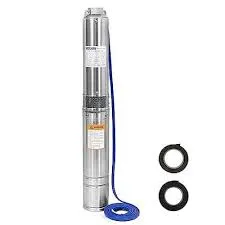Oct . 06, 2024 10:39 Back to list
submersible electric water pump
Submersible Electric Water Pumps A Comprehensive Overview
Submersible electric water pumps are vital tools in various fields, including agriculture, construction, and residential water management. These pumps are designed to operate underwater, making them exceptionally efficient for moving large quantities of water from one place to another. Their unique design not only enhances performance but also minimizes the risk of damage and wear compared to surface pumps. In this article, we will explore the working principles, applications, advantages, and considerations surrounding submersible electric water pumps.
Working Principles
The operation of a submersible electric water pump is relatively straightforward. The pump is sealed in a watertight casing, which allows it to be submerged underwater. When activated, an electric motor drives impellers within the pump, creating a difference in pressure that pushes water through the outlet. This design effectively reduces the risk of cavitation, ensuring consistent performance and longevity of the pump. Moreover, by submerging the motor and components directly in the water source, the pump operates more quietly and efficiently than surface alternatives.
Applications
Submersible electric water pumps are versatile and applicable in a variety of scenarios. In agriculture, they are frequently used for irrigation purposes, drawing water from wells or reservoirs to supply crops during dry spells. In construction, they serve to dewater excavation sites, thus enhancing safety and operational efficiency. These pumps are also widely used in residential settings for draining flooded basements or emptying swimming pools.
Moreover, submersible pumps have essential roles in wastewater management systems. They can efficiently transport sewage and other wastewater from homes and industries to treatment facilities, playing a crucial part in maintaining sanitation and hygiene in urban environments. Additionally, they are effective in managing stormwater, helping to mitigate the risks associated with flooding in heavy rainfall events.
Advantages
submersible electric water pump

One of the primary advantages of submersible electric water pumps is their efficiency. By functioning underwater, these pumps can move significant volumes of water with minimal energy consumption. This makes them a cost-effective solution, particularly in applications where large quantities of water need to be moved regularly.
Another significant benefit is durability. Submersible pumps are designed to withstand harsh conditions, including exposure to corrosive substances and debris common in waterways and wastewater systems. The sealed design protects the internal components from moisture ingress, reducing the likelihood of electrical failures.
Additionally, ease of installation is another attractive feature. Submersible pumps can be installed directly into wells or water bodies without the need for complex plumbing systems. This not only saves time but also reduces labor costs associated with extensive installations.
Considerations
While submersible electric water pumps offer numerous advantages, there are several considerations to keep in mind before purchasing one. Compatibility with specific water conditions is essential. Heavy debris or particles within the water can cause wear and tear on the impellers, leading to premature failure. Therefore, selecting a pump with appropriate filtering capabilities is crucial.
Furthermore, the power requirements of submersible pumps can be a significant factor. It's vital to ensure that the electrical supply can accommodate the pump’s needs without overloading circuits. Adequate maintenance is also essential to ensure longevity, which may include regular inspections and cleaning of the pump and its components.
Conclusion
Submersible electric water pumps represent an indispensable solution for various water management needs. With their efficient operation and wide array of applications, they offer significant advantages over traditional surface pumps. By understanding their working principles, applications, and considerations, users can make informed decisions that will lead to optimal performance and longevity of their pumps. As the demand for reliable water management systems continues to grow, submersible pumps will undoubtedly play a critical role in both industrial and domestic environments.
-
Submersible Water Pump: The Efficient 'Power Pioneer' of the Underwater World
NewsJul.01,2025
-
Submersible Pond Pump: The Hidden Guardian of Water Landscape Ecology
NewsJul.01,2025
-
Stainless Well Pump: A Reliable and Durable Pumping Main Force
NewsJul.01,2025
-
Stainless Steel Submersible Pump: An Efficient and Versatile Tool for Underwater Operations
NewsJul.01,2025
-
Deep Well Submersible Pump: An Efficient 'Sucker' of Groundwater Sources
NewsJul.01,2025
-
Deep Water Well Pump: An Efficient 'Sucker' of Groundwater Sources
NewsJul.01,2025
-
 Submersible Water Pump: The Efficient 'Power Pioneer' of the Underwater WorldIn the field of hydraulic equipment, the Submersible Water Pump has become the core equipment for underwater operations and water resource transportation due to its unique design and excellent performance.Detail
Submersible Water Pump: The Efficient 'Power Pioneer' of the Underwater WorldIn the field of hydraulic equipment, the Submersible Water Pump has become the core equipment for underwater operations and water resource transportation due to its unique design and excellent performance.Detail -
 Submersible Pond Pump: The Hidden Guardian of Water Landscape EcologyIn courtyard landscapes, ecological ponds, and even small-scale water conservancy projects, there is a silent yet indispensable equipment - the Submersible Pond Pump.Detail
Submersible Pond Pump: The Hidden Guardian of Water Landscape EcologyIn courtyard landscapes, ecological ponds, and even small-scale water conservancy projects, there is a silent yet indispensable equipment - the Submersible Pond Pump.Detail -
 Stainless Well Pump: A Reliable and Durable Pumping Main ForceIn the field of water resource transportation, Stainless Well Pump has become the core equipment for various pumping scenarios with its excellent performance and reliable quality.Detail
Stainless Well Pump: A Reliable and Durable Pumping Main ForceIn the field of water resource transportation, Stainless Well Pump has become the core equipment for various pumping scenarios with its excellent performance and reliable quality.Detail
